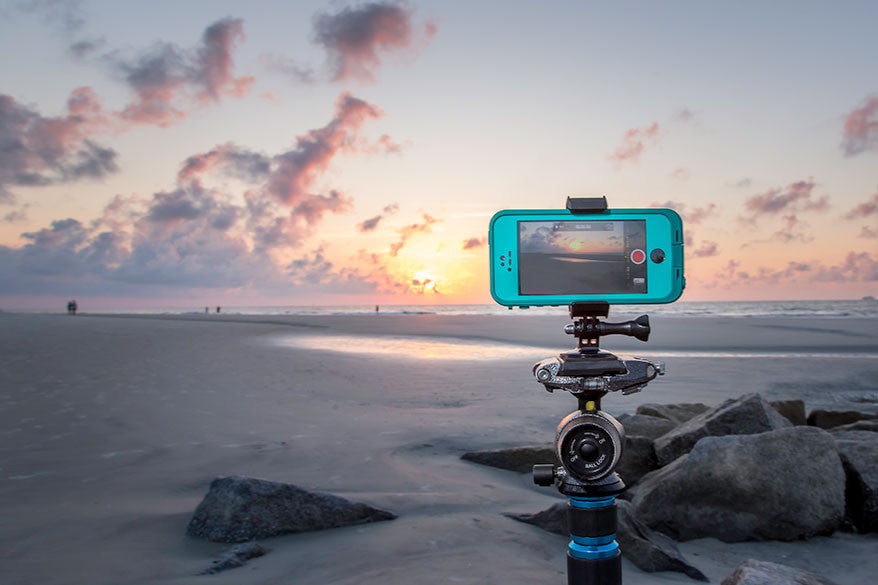5 Smartphone Photography Tips for Better Photo & Video
A new year is here, and it’s time to take your photo and video to the next level with our 5 smartphone photography tips.
Not all of us have a DSLR, GoPro, and/or Drone to snag that epic footy. Even if you do, you should never leave behind a good backup. The Smartphone, while not the best out there, is still an excellent choice for beginners looking to get started and for professionals needing a second angle (and who knows when the action will find you without a GoPro?). For action/adventure photographers, videographers and iPhoneographers that are ballin’ on a budget and need pro shots, these smartphone photography tips are for you.
Tip #1: Settings
While you might think it goes without saying, the primary settings on your phone's camera should never be overlooked. Here are some to look out for (most of these are available on both Apple and Android devices):
Grids
Using a grid with your camera app lets you to size up the picture against visible lines, break up the image into sections and capture your subject with respect to the Rule of Thirds (see #5). It's an easy visual guide to help you compose a show-stopper, or at least an Insta-scroll stopper.

HDR
When activated, HDR (high-dynamic-range imaging) snaps three quick shots (underexposed, overexposed and normal photos) and combines them to achieve perfect contrast. Overall, HDR is a solid go-to setting in challenging lighting or for quick photo-ops.

Aspect Ratio
Double check your camera's settings to ensure you're using the highest resolution available, and don't change up the aspect ratio to 16:9 unless you know for sure that you have a 16:9 image sensor (most are 4:3). If you want widescreen images or video, crop them later (see #3) instead of limiting the view of your camera's sensor.
Auto White Balancing
Experimenting with your camera's white balance settings (or using a third-party camera app to get around your iOS device's auto white balance) can give you a whole new range of photographic possibilities. You can correct harsh fluorescent lighting, "warm up" over-exposed daytime shots as well as snap unique, unnatural colors for your artsy camera roll.
Voice Control
An easy hack for increasing camera stability is to set up voice control of your camera app. That way you can use both hands to stabilize your phone and you don't have to tap the screen and botch your camera's focus at the worst possible moment.
Auto Stabilization
Cashing in on your camera's auto stabilization (or getting an app that has it) is a quick way to remedy the shakes common in smartphone videos, but they can only help smooth out light turbulence. Scroll down to #2 for the best tools for stabilization.
File Storage
A vital aspect of digital photography, file storage can derail a photo session if you run out of memory on your device in the middle of a shoot. Backing up photo and video with Google Drive or Apple's iCloud after each session will ensure you have the space to snap as many photos as you need to get the perfect shot.
There are loads of apps and settings out there. Explore and see what works best for you and your device.
Tip #2: Accessorize

We build and sell the best mobile photography and iphonography products we possibly can, so if you need a tripod mount or a stable handheld mount go with the FreeRide Phone Mount. Outside of these needs there are still plenty of important accessories to consider if you want to get the best shots from your phone… especially if it's riveting action or adventure footage.
One of our biggest recommendations for accessories is undoubtedly lenses. There really is no faster way to turn your phone into a powerhouse capture machine than investing in a high-quality lens pack. We carry olloclip iPhone Lenses because they are the best.
Running out of power will ruin your day. Having standby power such as an Outdoor Tech Kodiak USB Power Bank guarantees you'll have power and never miss a shot.
Another easy one is a reliable case. Hitting some surf or powder? Consider a highly secure case that will keep everything clean and dry.
Need to steady the shot and take a step back? Tripods could be the answer, especially if you are out there shooting solo.
Beyond accessories, check out ways to expand storage (on some Android models), apps to help aid photo capture/composition and microphones if you need good audio (common for vloggers).
Pro #3: Edit After Shooting
While you might be tempted to enhance the initial capture with fancy bells and whistles, there is way more value in getting the perfect shot and editing afterwards. You should be more concerned with working the scene, getting the best shots possible and really crushing the capture than anything else. Once the epicness is in your storage, that’s where the magic starts:
Never zoom, always crop. Digital zoom on phones (despite the advancements in technology across devices) is still trash. You are far, far better off taking the shot, cropping it after, and blowing it up to size later.
Who needs filters when you can edit? Look, we all love filters. But you can get better results with editing software. Whether it’s an editing app on your phone or Photoshop (or one of its free competitors) on your computer, taking a couple hours to learn how to adjust colors, saturation and contrast will let you get things looking exactly how they need to look to blow up on the gram.
Front camera? Not even once. There is no debate here. If you need to hold the cam steady why not scroll to Tip #1 and check out voice command features (if available on your device).
Stabilization is your friend. While the built-in stabilizers are pretty decent on some smartphones, you are probably better off bouncing footage to a program like Premier Pro and using its stabilizers. This can really make the difference and save great footage that was just too shaky before.
Pro #4: Shoot Video in Airplane Mode
The thought of all the sick footage that has been ruined by a call from work, or the bank, or mom, or anyone else absolutely breaks our hearts. This tip is a little lightweight compared to the rest, but we include it because it is mission critical!
There are two types of people in this world: those who don’t care to turn on airplane mode while shooting footage because it hasn't happened to them, and those who have and will never forget to do it again.
Pro #5: Learn the Basics of the Craft
This has less to do with your phone, and it probably receives way too much attention in the other guides we have come across, but it still stands: Photography and videography are arts, and there are a couple centuries worth of masters who have created best practices for you to follow.
Do the following terms ring a bell?
Rule of Thirds
A concept to help you compose interesting and aesthetically appealing imagery. In short, divide your camera's view into thirds vertically and horizontally (a nine square grid) and orient the horizon, your subject, lines or other points of interest along these invisible lines. A grid setting can help get you rolling.

Fill the Frame
When taking portraits, it's good practice to fit people tight in the frame instead of stepping back and letting the background swallow them. This is true for wildlife, pets and other subjects that benefit from closer perspectives. If you want to photograph something, get in there and make it the undisputed focal point.
Line Out
In photography, lines are your friends, especially lines that lead the viewer's eyes out from the foreground into the background, providing depth. A road or shoreline extending to the horizon are great examples. Diagonal lines, curvy lines, implied lines and S-curves are all interesting and worth fitting into your compositions.

Rule of Odds
Simply put, take pictures of odd things. No, not weird things (well, that works for some people). We mean odd numbers. It has been proven that compositions with odd numbers of people, puppies, pieces of pie, etc. are more visually appealing and make for well-balanced photographs. This probably won't work for wedding photography, but hey, these are guidelines.
Never heard this stuff before? It's time to study up! Learning from those who have come before you will move you one step closer to taking professional-quality smartphone photos (and then tagging #GoWorx when your Instagram picture gets 83 million views).
We hope you enjoyed this fresh perspective on stepping up your smartphone photography game. The phone should not be overlooked as an excellent secondary camera for pros and a completely suitable primary camera for anyone! If you have your own tried-and-true smartphone photography tips, please let us know!


